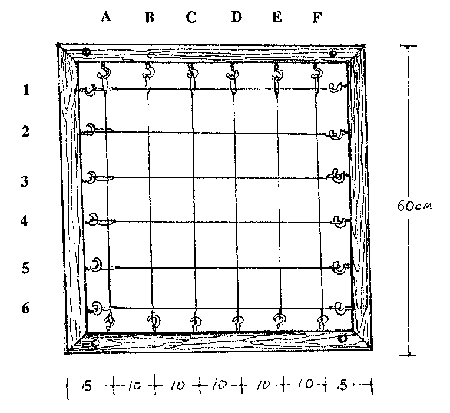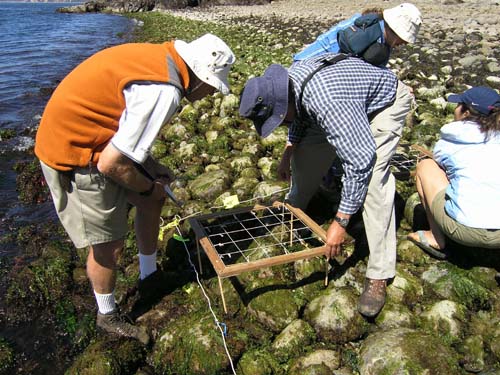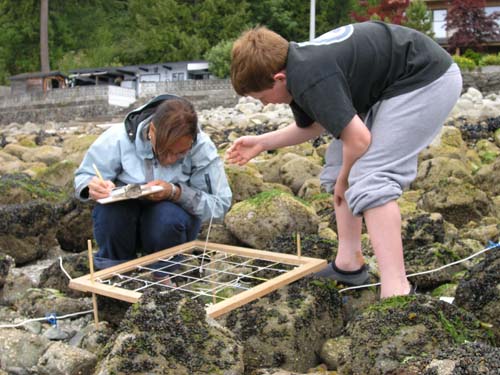Methods for Coastal Scene Investigation
How have studies been conducted in the past and how can you conduct your own study?
A detailed way to make a record of species found at a beach over time is to perform a quadrat study. A quadrat study is a statistical survey used to determine relative abundance of each algae or animal by evaluating the percent cover found within the quadrat. Information collected in the quadrat can be extrapolated to the animals and algae found on the rest of the beach with similar substrate. All of the CSI study sites are at the mid to low intertidal zone and are on the rocky areas of the beaches. The technique described here is for rocky intertidal surveys. See the photographs below for an example of what one CSI site looks like.
To do your own quadrat study you must pick the tide zone at the beach you are going to study. The choice of a low tide quadrat will probably result in finding a larger number of species but can be difficult to schedule due to the infrequency of an extremely low tide. By choosing a mid tide zone you will still see lots of interesting organisms but you will also have a wider time frame available to do the study. Therefore the mid tide zone is the most interesting and assessable. The day that you do your study the tide should be lower than 1 meter (this can be checked in the local newspaper).
You should find an area of the beach you have chosen that is in your chosen intertidal zone and that is rocky. It is best to choose a beach with rocks that can be turned over because this will allow you to study organisms underneath the rocks. The quadrat size used in past studies has been 3.5 m x 3.5 m but you can choose a smaller quadrat area to start with and increase its size later if you wish. It is also important to have a method of finding the same location of your original study year after year. To do this, note landmarks and take pictures of the area and the quadrat. Also, if available, take GPS (Global Positioning System) readings of the quadrat location. This allows for a permanent plot to be made so that it can be studied annually or some time in the future so that data can be compared.
The larger quadrat is looked at in smaller blocks. To do this, a gridded quadrat frame is used. Follow instructions below to make your own gridded quadrats. Each quadrat frame will be divided into 10 cm x 10 cm squares. Use the dowels to level the frame (see photo below). At each intersection of the squares use a plumb bob (see photo below) to find the plant or animal directly under it. It is important that you record only the uppermost plant or animal because this is a statistical survey. At some intersections you will find only sand, rock, or shell. However, it is still important to record these points as the percentage of open space in the quadrat will be calculated from that data. For this study, do not record anything that is not directly under the intersections. It is easiest to have one person identify the organism while the other records the data. Clipboards are useful when recording data and taking pictures of the quadrat and plants and animals found is also useful.
Each gridded quadrat section should be given an identifying letter-number combination as you work over the larger quadrat area and each should have 36 samples (or 36 intersection points where data was collected). Click here to see 36 quadrats from the Hornby Island site, summer 2004. When the survey is finished, calculate the percent cover of all plants, animals and free space observed. You do this by adding all of the recorded points where you reported one particular organism, dividing by the total number of intersections surveyed and multiplying by 100.
Percent Cover = (# of intersections organism ‘a' was observed) / (number of gridded quadrats used x 36) x (100)
For example, if you marked out two quadrat frame areas and found rockweed (Fucus gardneri) at eighteen intersections, the percent cover of the rockweed is 18 / (2 x 36) x 100 = 0.25 or 25%.
After the quadrat study is done, remove the gridded quadrat frames and divide your study area into a large grid with 60 cm x 60 cm squares using strings.
Going from one section to the next, look beneath each rock one at a time and record the type and number of organisms found.
It is important to remember to carefully replace each rock in its original position before proceeding to the next rock. See beach etiquette for more details on beach exploration guidelines. Sometimes it is difficult to identify all of the algae species. In this case, you may want to take a sample of each algae species that you can not identify and preserve it with herbarium paper for later identification. However, this is not required. Click here for directions on preserving algae.
If you have problems identifying animals, take photographs of them and solicit help from local universities and museums to identify them.
The more people involved in the study the better! You will be able to take on larger quadrat areas with more ease and more people will have the chance to learn about intertidal diversity. This would be a very good school project; a class could adopt a beach and monitor it once a year, during the same season each year. Follow the links on this site to see areas already studied and pictures of plants and animals and volunteers.
Equipment Needed for the Study
- Quadrat
- Measuring tape
- Digital camera
- Notebook
- Clipboards
- Data sheets
- Pencils
- Field guide
- Plumb bob
- Waterproof paper
- Extra elastics, erasers
- Hats
- Sunscreen
- Water and snacks
- First aid kit
- Optional: GPS, herbarium paper, newspaper, cardboard and flower press.
Making Your Own Quadrat Frame:
Materials Needed:
- Wood – four pieces ¾'' x 1 ¾'' x 70 cm
- Cup hooks – 24
- String – about 10 meters
- Elastic bands – 12
- Dowels – four, each ¼'' x 30 cm
- Plumb Bob – String with a weight attached to bottom
Instructions:
- The frame should be built to measure 60 cm x 60 cm on the outside edges and the corners should be braced for strength.
- Screw the cup hooks into the interior edge of the wood at 10 cm intervals, except for the points closest to the edges which should be at 5 cm intervals (see figure below).
- Make one knotted loop at one end of the string and attach an elastic to the other end. This makes for easy removal of the strings.
- Attach strings to cup hooks to form a grid.
- Drill four ¼ inch holes through the frame close to each corner for the ¼ inch dowels.
- Round and sand one end of each dowel for easy insertion into the frame. If dowels fit too tightly, rub them with a dry bar of soap to lubricate.
- Make a plumb bob by attaching a weight to the end of a string.
Drawing of a completed gridded quadrat:

Volunteers and Gridded Quadrat

Volunteers using a plumb bob 
|

